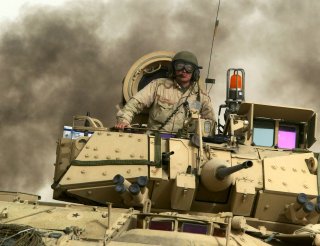The U.S. Army's New Optionally Manned Fighting Vehicle: Coming Soon?
How will the newer, high-tech vehicle help improve the Army's ability to wage and win war?
The U.S. Army is preparing to review proposals for its new Optionally Manned Fighting Vehicle, an infantry carrier intended to use manned-unmanned teaming, next-generation networking technology, advanced weapons and AI-enabled sensors.
“From the beginning we said we would learn early and learn our lessons quickly. We have released a request for proposal for a design concept and will receive design proposals later this month,” General Joseph Martin, Army Vice Chief of Staff, told an audience at a recent event at the Foundation for the Defense of Democracies.
The industry proposals are expected to include several industry competitors as well as an internal Army design team, Martin explained.
The new platform, part of the Army’s emerging family of Next-Generation Combat Vehicles, seeks to incorporate the service’s new vision for modern Combined Arms Maneuver. New weapons and sensing precision and ranges, coupled with advanced electronics and engineering are expected to deliver a faster, lighter-weight, more lethal and much better networked vehicle than the Bradley Fighting Vehicle it is replacing.
“Optionally-Manned” is an operative term here, as the vehicle is being engineered to operate with new levels of autonomy and AI-enabled navigational systems, enabling the vehicle to perform high-risk missions without placing soldiers in harm’s way. At the same time, the OMFV is also engineered to coordinate with the Army’s Robotic Combat Vehicle platforms, emerging systems which also draw upon new levels of autonomy, weaponry and advanced computer algorithms. The concept is to offer “options” to commanders who might need to make rapid adjustments amid a fast-moving dynamic combat environment.
Army developers have told The National Interest that the new vehicle will likely operate with a three-man crew, carry six-soldiers in back and ultimately fire a 50mm cannon. The new longer-range “TOW missile-compatible” weapons may arm the new platform, senior Army developers said, as a way to destroy enemy armored vehicles at a safer stand-off range. Also, these new missiles are very likely to be configured with newer, more varied explosives able to destroy enemy tanks, armored vehicles and infantry formations to a much greater extent than existing weapons can.
These kinds of new platforms are already shaping Army maneuver formations given the massive extent to which new technology enables different warfare tactics. For instance, an ability to conduct unmanned forward operations could allow forces to disperse, coordinate targeting from standoff distances and test enemy defenses. Also, an unmanned vehicle could also, of course, with human controllers, conduct attacks and fire weapons. Unmanned systems could also support dismounted infantry in some cases by traversing rigorous terrain and bringing armored support to advancing ground units.
Also, new platforms are being increasingly engineered with common technical standards such that they can conduct “joint” attack operations with Air Force and Navy platforms.
Kris Osborn is the new Defense Editor for the National Interest. Osborn previously served at the Pentagon as a Highly Qualified Expert with the Office of the Assistant Secretary of the Army—Acquisition, Logistics & Technology. Osborn has also worked as an anchor and on-air military specialist at national TV networks. He has appeared as a guest military expert on Fox News, MSNBC, The Military Channel, and The History Channel. He also has a Masters Degree in Comparative Literature from Columbia University.
Image: Reuters

